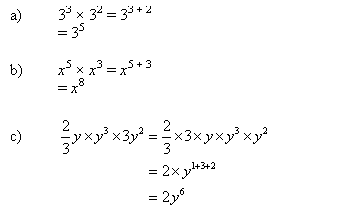Adding Exponents
What happens when numbers with exponents are multiplied?
Related Topics:
Introduction to Exponents
Rules of Exponents
Using Exponent Rules
When multiplying numbers in exponent notation with the same base, we can add the exponents.
Consider:

This is the first law of exponents:
Example:
Simplify the following; give your answers in exponent form

Solution:

Common Error : The first law of exponents does NOT apply to addition of numbers in exponent notation.
First Law of Exponents
Laws Of Exponents
Explains all the different laws of exponents
Try out our new and fun Fraction Concoction Game.
Add and subtract fractions to make exciting fraction concoctions following a recipe. There are four levels of difficulty: Easy, medium, hard and insane. Practice the basics of fraction addition and subtraction or challenge yourself with the insane level.

We welcome your feedback, comments and questions about this site or page. Please submit your feedback or enquiries via our Feedback page.